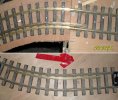Rhinochugger
Retired Oik
Ah, my track is only fixed in a few places - every ten foot or so , and only on the crucial bridge approaches where it sits in ballast.One mistake I made initially was using stubby off-cuts of track to bodge the correct alignment geometry on curves. These end up distorting and ultimately coming apart as the joiners alone have too much give where the track's not bolted down.
That length of track in front of the fruit cage has only 3 or 4 fixings in the whole length.


